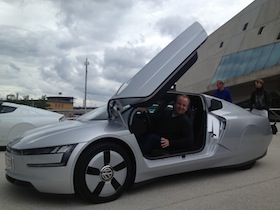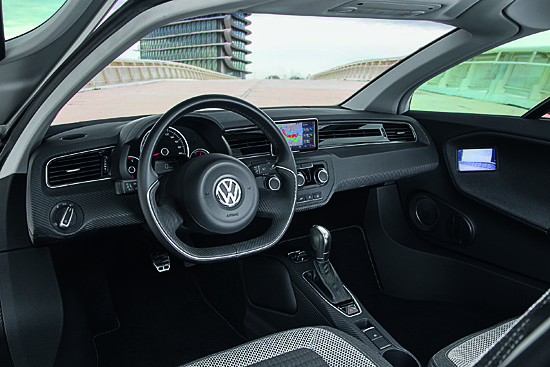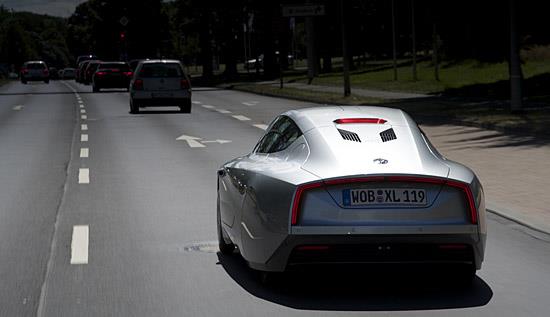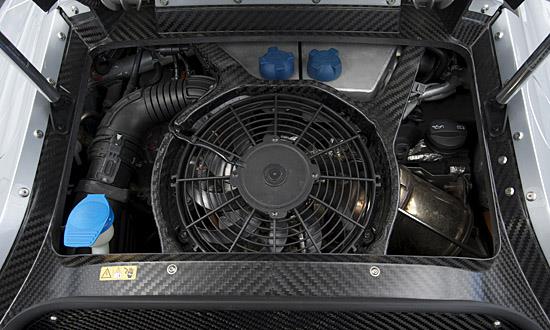
It’s sort of like puttering around a lake in a small outboard motorboat. Believe me, you'll get over it. This diesel-electric plug-in hybrid gets 261 mpg on the European cycle, which Volkswagen says makes the XL1 the most efficient production car in the world.
These journalists had me thinking it was like a Colombian drug submarine in there, and it’s just not. It’s a little noisy, but what were you expecting from a 2-cylinder diesel engine that’s a stressed member, mounted a couple feet behind your head? There’s the occasional vibration, too – for you racy types, think of it as what your car feels like with stiffer engine mounts.
But around town, you’re going to be in electric mode, which is good for about 31 miles of driving on the car's 5.5-kilowatt-hour lithium-ion battery, which needs about an hour and a half to recharge on 220 volts. In other words, you ain’t gonna be paying much for your daily commute.
It’s not really that slow, either. That little diesel engine puts out 48 horsepower and 89 ft-lb of torque, and the electric motor does about 27 horsepower and 103 lb-ft of torque (total system power is 68 horsepower and 103 lb-ft of torque). A 7-speed dual-clutch automatic gearbox really helps to leverage the limited oomph.
When you look at the XL1 from the outside, you really think you’re about to get into a cobbled-together kit car. But that’s just not the case. You’d be hard pressed to find differences in the fit and finish compared with the company's best-selling Golf. I’m a bit of a minimalist, so I like the fact that the controls inside the XL1's 197-pound carbon monocoque cabin are so intuitive. There’s the familiar Volkswagen switchgear and a simple climate control system. There’s also a big button for air conditioning and a small screen for your Garmin navigation, as well as the more-or-less standard suite of hybrid data-visualization stuff.

The rear view mirrors are “e-mirrors,” which display on LCD monitors inside each door. There’s no power steering, but it just doesn’t matter in a car that weighs 1,753 pounds, and besides, it means there’s feedback in the wheel! (With today's electric power steering racks, I’d almost forgotten what that felt like.) The column itself is manually adjustable for reach. The one-piece carbon fiber seats are adjustable for tilt and fore/aft only. The windows crank open with a flip-out manual winder, and they don’t open much. Think Subaru SVX.
The other gripe I keep hearing from my colleagues is that the XL1 isn’t fun to drive, which is also nonsense. Like Porsche says about its 911 GT3 to justify the lack of a proper manual transmission, it’s just a different kind of fun. In the case of the XL1, there’s a chuckle that comes from knowing that you’re sticking it to the Man – like you’re getting away with something because you spend less on gas than you do on paper clips in a year.

And the feeling of beating the system comes often, like when you delicately ride the carbon ceramic brakes toward a stop sign, knowing that you’re charging the battery in the process. Or when you get going about 70 mph, then let off the gas and the XL1 just coasts for what feels like forever, eerily unimpeded by friction. With the tiny 830cc engine switched off in traffic, the XL1 feels like a glider among a sea of Boeing 727s, sailing effortlessly from one thermocline to the next.
The XL1 isn’t going to set any handling records with its very narrow (and very proprietary) Michelin tires (115/80 R16 up front and 145/55 R16 at the back), but there is something entertaining about piloting it off an exit ramp, just because you feel everything. You know what the chassis is doing and exactly where the wheels are aimed.
As you might expect, the XL1 turns heads. This aerodynamic jellybean really does look like the car of the future, and everybody – I mean everybody – does a double take. I told you about the e-mirrors, but everything about the XL1 is designed to cut drag, netting an incredible .189 Cd (for reference, a Prius does about 0.25). The XL1 boasts a completely flat underbody, and even the engine cooling, for example, is done from the back of the car, where the air is most turbulent.

Cool air is sucked in through the diffuser, and hot air goes out the top, aided by a SPAL “puller” fan set atop the tiny diesel. As long as we’re talking about the rear end of the car, I should mention that there’s a tiny trunk – enough for a small carry-on bag and a laptop bag on top of that. Even the wiring in the XL1 has been converted to aluminum to save a few pounds – and the dashboard is partially wood.
There are no plans to bring the XL1 to the United States (these cars cost Volkswagen a fortune to build, and as a populace we aren’t exactly receptive to small cars), but you should wish they would. I’m completely shocked to find myself a fan.
James Tate cut his teeth in the business as a race-team crew member before moving to the editorial side as senior editor of Sport Compact Car, and his work has appeared in Popular Mechanics, Automobile, Motor Trend and European Car. When not writing, Tate is usually fantasizing about a vintage Porsche 911.
Have a story idea? Tip us off at exhaustnotes@live.com.
Source: MSN
No comments:
Post a Comment